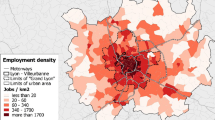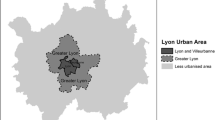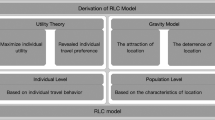Abstract
Residential location choice (RLC) predicts where and how people choose their residential location in the framework of land use–transport interaction models (LUTI). This paper seeks an efficient RLC model in the context of irregular zoning of location alternatives. The main current proposals in the field are discrete choice models. In RLC modeling, the alternatives are spatial units, and spatially correlated logit (SCL) is an efficient approach when the analyst cannot pre-define groups of alternatives that efficiently reflect the systematic substitution patterns among the alternatives. The SCL uses the spatial information on the contiguity of the zones to determine spatial correlation among the alternatives. Urban residential location choice usually uses administrative zoning, which is very irregular in many cities (mainly historic cities); however, SCL is not efficient in this context owing to the limitations of the binary contiguity spatial variable employed as a spatial correlation metric (SCM). This paper proposes an extension of the mixed SCL model, with an SCM based on the proportion of common border length in contiguous zones, which is more efficient in the irregular urban zoning context. The proposed model is applied to an urban case study of LUTI RLC modeling with irregular zoning, based on the administrative divisions of the city of Santander (Spain) and is shown to be empirically more efficient than the previous approaches.



Similar content being viewed by others
Notes
A model is nested with other when it contains the same parameters and at least one more.
The likelihood of a nested model with other is at least equal to that of the other.
The Wilks’s statistic of a model with likelihood L1, nested with other with likelihood L2, is \( -2\mathit{\log}\frac{L_2}{L_1}=-2\left({LL}_2-{LL}_1\right), \) where LL = logL, named log-likelihood.
McFadden’s LRI=\( 1-\frac{LL(model)}{LL\left( null\_ model\right)} \)
Akaike-adjusted LRI=\( 1-\frac{LL(model)-p}{LL\left( null\_ model\right)} \)
References
Alonso W (1960) A theory of the urban land market. Pap Reg Sci Assoc 6:149–157
Alonso W (1964) Location and land use. Harvard University Press, Cambridge, MA
Anas A (1981) The estimation of multinomial logit models of joint location and travel mode choice from aggregated data. J Reg Sci 21(2):223–242
Anselin L (1988) Spatial econometrics: methods and models. Kluwer Academic, Boston, Mass
Anselin L, Rey S (1991) Properties of tests for spatial dependence in linear regression models. Geogr Anal 23(2):113–131
Ben-Akiva M, Bierlaire M (1999) Discrete choice methods and their applications to short-term travel decisions. In: Hall R (ed) Handbook of transportation science, pp 5–34
Ben-Akiva M, Bierlaire M (2003) Discrete choice models with applications to departure time and route choice. In: Hall R (ed) Handbook of transportation science, 2nd edn. Kluwer, pp 7–37
Bhat CR (1998) Accommodating flexible substitution patterns in multidimensional choice modeling: formulation and application to travel mode and departure time choice. Transp Res 32B(7):425–440
Bhat CR (2000) Incorporating observed and unobserved heterogeneity in urban work travel mode choice modeling. Transp Sci 34:228–238
Bhat CR, Guo J (2004) A mixed spatially correlated logit model: formulation and application to residential choice modeling. Transp Res B Methodol 38(2):147–168
Bierlaire M (2003) BIOGEME: a free package for the estimation of discrete choice models. Ascona, Switzerland, 3rd Swiss transportation research conference
Chasco C (2002) Econometría Espacial aplicada a la predicción-extrapolación de datos microterritoriales (Doctoral dissertation, Universidad Autónoma de Madrid)
Chernew M, Gowrisankaran G, Scanlon D (2003) Learning and the value of information: the case of health plan report cards, submitted to international economic review
Chu C (1989) A paired combinatorial logit model for travel demand analysis. Proceedings of the fifth world conference on transportation research 4, Ventura, CA. 295-309
Cliff A, Ord J (1973) Spatial autocorrelation. Pion, London
Coppola P, Nuzzolo A (2011) Changing accessibility, dwelling price and the spatial distribution of socio-economic activities. Res Transp Econ 31:63–71
Dacey MF (1969) Similarities in the areal distributions of houses in Japan and Puerto Rico. Area 3:35–37
Daly AJ and Zachary S (1978) Improved multiple choice models. In: Hensher DA and Dalvi MQ (eds), Determinants of travel choice (Westmead: Saxon House), pp. 335–357
Dell'Olio L, Cordera R and Ibeas A (eds) Alonso A, Alonso B, Barreda R, Comi A, Coppola R, González E, Monzón A, Moura J, Nogués S, Nuzzolo A, Orro A, Papa E, Perez-Lopez J-B, Reques P, Sañudo R and Wang Y (2016) Land use - transport interaction models. The TRANSPACE model. 1st edn. Santander: GIST
Domencich TA, McFadden D (1975) Urban travel demand: a Behavioural analysis. American Elsevier, New York
Florax RJGM, Rey S (1995) The impacts of misspecified spatial interaction in linear regression models. In: Anselin L, Florax RJGM (eds) New directions in spatial econometrics, advances in spatial science. Springer, Berlin, Heidelberg
Geurs KT, Van Wee B (2004) Accessibility evaluation of land-use and transport strategies: review and research directions. J Transp Geogr 12:127–140
Gumbel EJ (1958) Statistics of extremes. Columbia University press (facsimile by UMI, Michigan, 1997)
Hajivassiliou VA, Ruud PA (1994) Classical estimation methods for LDV models using simulations. In: Engle R, McFadden D (eds) Handbook of econometrics IV. Elsevier, New York, pp 2383–2441
Hess S, Bierlaire M, Polak J (2005) Capturing taste heterogeneity and correlation structure with mixed GEV models. In: Scarpa R and Alberini A (eds), Applications of simulation methods in environmental and resource economics, Springer Publisher, Dordrecht, the Netherlands, chapter 4, pp. 55–76
Hunt LM, Boots B, Kanaroglou PS (2004) Spatial choice modelling: new opportunities to incorporate space into substitution patterns. Prog Hum Geogr 28-6:746–766
Ibeas A, Cordera R, Dell’Olio L, Coppola P (2013) Modeling the spatial interactions between workplace and residential location. Trans Res A 49:110–122
Koppelman FS, Wen CH (2000) The paired combinatorial logit model: properties, estimation and application. Transp Res 34B:75–89
Lee LF (1992) On efficiency of methods of simulated moments and maximum simulated likelihood estimation of discrete response models. Economet Theor 8(4):518–552
Ma J, Haining R, Wise S (1997) SAGE user’s guide. Sheffield Center for Geographic Information and Spatial Analysis, University of Sheffield
McFadden D (1974) Conditional logit analysis of qualitative choice behavior. In: Zarembka P (ed) Frontiers in econometrics. Academic Press, New York, pp 105–142
McFadden D (1978) Modelling the choice of residential location. In: Karlqvist A, Jundqvist L, Snickars F, Weibull J (eds) Spatial interaction theory and planning models. North Holland. Amsterdam, pp 75–96
McFadden D, Train K (2000) Mixed MNL models for discrete response. J Appl Econ 15-5:447–470
Moreno R, Vayá E (2000) Técnicas econométricas para el tratamiento de datos espaciales: la econometría espacial. Edicions Universitat de Barcelona, Barcelona
Papola A (2004) Some developments on the cross-nested logit model. Transp Res 38B(9):833–851
Perez-Lopez J-B and Orro A (2016) Residential location choice models with spatial correlation. In: L Dell’Olio, R Cordera and A Ibeas (eds) Land Use - Transport Interaction Models. The TRANSPACE model. Santander: GIST, pp. 114–150
QGIS Development Team (2018) QGIS geographic information system. Open Source Geospatial Foundation Project. http://qgis.osgeo.org
Sener IN, Pendyala RM, Bhat CR (2011) Accommodating spatial correlation across choice alternatives in discrete choice models: an application to modeling residential location choice behavior. J Transp Geogr 19:294–303
Small KA (1987) A discrete choice model for ordered alternatives. Econometrica 55(2):409–424
Stetzer F (1982) Specifying weights in spatial forecasting models: the results of some experiments. Environ Plan 14A(5):571–584
Train KE (2003) Discrete choice methods with simulation. Cambridge University press, 2003
Torrens PM (2000) How land-use transportation models work. Centre for Advanced Spatial Analysis, London
Thurstone L (1927) A law of comparative judgment. Psychol Rev 34:273–286
Vovsha P (1997) The cross-nested logit model: application to ode choice in the Tel-Aviv metropolitan area. Transp Res Rec 1607:6–15
Wegener M (1994) Operational urban models: state of art. J Am Plan Assoc 60(1):17–29
Wen CH, Koppelman FS (2001) The generalized nested logit model. Transp Res B Methodol 35(7):627–641
Wilks SS (1938) The Large-Sample Distribution of the Likelihood Ratio for Testing Composite Hypotheses. The Annals of Mathematical Statistics, Vol. 9, No. 1 (Mar., 1938), pp. 60–62
Williams HCWL (1977) On the formation of travel demand models and economic evaluation measures of user benefit. Environ Plan 9A:285–344
Acknowledgements
The authors acknowledge the financial support provided by the Government of Spain under the projects TRA2012-37659 and RTI2018-097924-B-I00 MCIU/AEI/FEDER, UE.
Author information
Authors and Affiliations
Corresponding author
Additional information
Publisher’s note
Springer Nature remains neutral with regard to jurisdictional claims in published maps and institutional affiliations.
Rights and permissions
About this article
Cite this article
Pérez-López, JB., Novales, M., Varela-García, FA. et al. Residential Location Econometric Choice Modeling with Irregular Zoning: Common Border Spatial Correlation Metric. Netw Spat Econ 20, 785–802 (2020). https://doi.org/10.1007/s11067-020-09495-5
Published:
Issue Date:
DOI: https://doi.org/10.1007/s11067-020-09495-5




